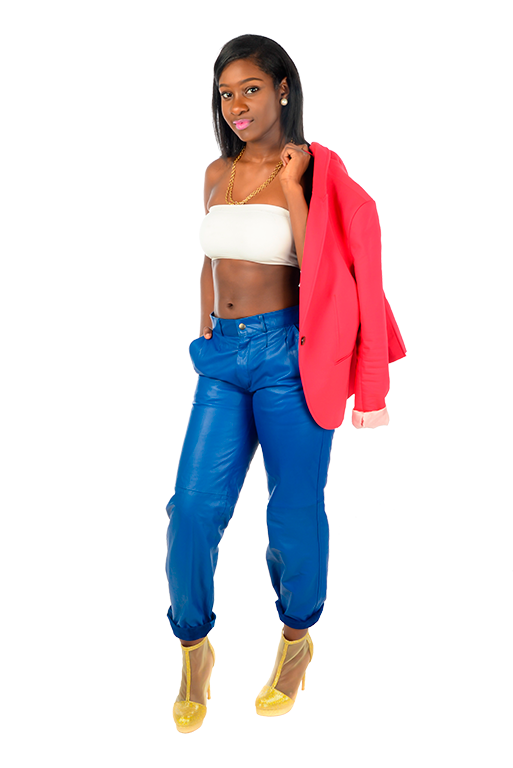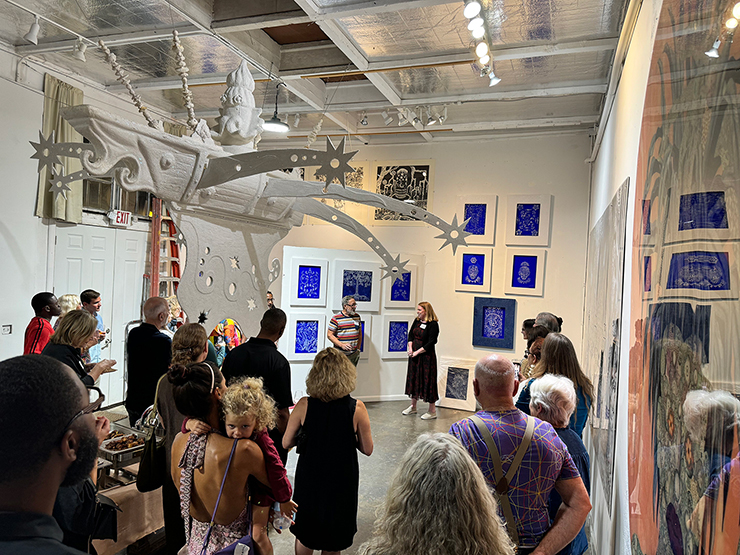
"Embellish Me" welcome party at artist Edouard Duval-Carrié's studio. Duval-Carrié talks with FIU Frost curator Amy Galpin. (Photo courtesy of FIU's Frost Museum)
Many of Miami’s active art collaborations nourish body and soul; or conversely, freak the bejeezus out of us with the unstable nature of…well…nature.
The phrase, “stick your head in the sand” comes from the misconception that ostriches hide their tiny heads.
They don’t. But to make sure South Florida isn’t a better example of the meaning of the myth, Miami-Dade has a number of thoughtful art exhibitions this season. Remove leftover summer cobwebs and jump into ideas and action before we lose any visible beach to stick our brains into.
"Biscayne Bay," The Kampong National Tropical Botanical Garden and Bridge Initiative
I’m willing to bet you haven’t visited The Kampong National Tropical Botanical Garden (NTBG) in the Coconut Grove neighborhood of Miami recently. Its on-site art exhibition titled “Biscayne,” a collaboration between Bridge Initiative and The Kampong honors Biscayne Bay’s heritage and future.
Billed as Art for Environmental Advocacy, Bridge Initiative (est. 2018) overlaps art, science and environmental issues to educate, inform and activate residents on future environmental health while drinking in the nine-acre historical Kampong garden walk into our natural past. The bay makes Miami visually interesting.
Tell me you still notice our watery best feature every single day as you pass over Biscayne Bay causeways hell-bent to get to the other side.
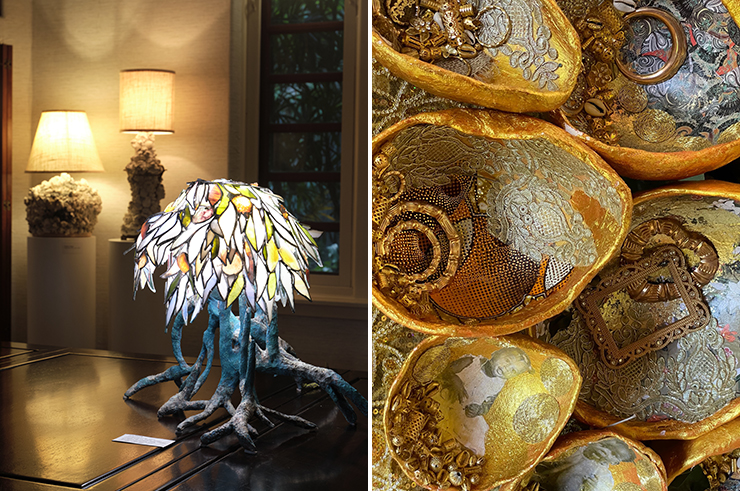
LEFT: Lee Pivnik (Mangrove) and Paloma Teppa (Coral), (Photo courtesy of the Kampong). RIGHT: Loni Johnson, "Pods," (a close-up of the mixed media work) at The Kampong, Coconut Grove. (Photo by Irene Sperber).
South Florida has been discovered, added to, subtracted from…portions are lost forever. Thirty five local and international artists effectively string together meaning and depth to time and tide; tide that now threatens to overwhelm our shores. Noted artists of various ages and genres revisit basic life-affirming foundations with thoughtful visual statements surrounded by the natural lushness of the Kampong.
“Biscayne Bay,” the exhibition theme, is on the National Register of Historic Places. The 1928 house on the land belonged to David Fairchild, and subsequently saved by botanist Kay Sweeney from developers after Fairchild’s death.
Bridge Initiative nudges us to listen closely to the waning quality of water sustaining the megalopolis as a modern world overwhelms. NTBG is “dedicated to tropical plant research, conservation, and education since 1964.” Can art be a red flag to point us away from an unfortunate future?
I spoke with “Biscayne” exhibition curator and Bridge Initiative founder Katherine Fleming. Her initial project was in southeast Alaska, but for the last 4 years projects have been here. Fleming pointed out: “South Florida really is the canary in the coal mine of climate change. And all other coastal cities are looking to us.”
“I went with my father on a Lindblad National Geographic expedition to Antarctica, and that is where my life changed,” says Fleming. She previously was creative director/director of fashion design in New York). "I decided I needed to do something, bringing art and pop culture as a vehicle to do science communication and explain climate change to the masses in a way that would be more understandable than scientific papers.”
Fleming sums it up with this statement: “One of the things that I really believe is that art has the power to make people fall in love with something. And when you love something, you want to protect it. So, the environment, or your heart, can communicate their complicated things in a very simple way, which is a big motivator for people.”
A few of the remarkable artists include Carlos Betancourt, Purvis Young, Antonia Wright and Michele Oka Doner, long an advocate of Florida’s natural gifts. Miami International Airport is set apart from other airports by Florida native Oka Doner’s spectacular terrazzo terminal floor, “A Walk on the Beach.”
Curator Katherine Fleming suggested reading the book ‘Bubble in the Sun’ “ (covering Florida's building boom of the 1920s and how it factored in the great depression)
“Florida has always been kind of based on illusion,” says Fleming. I followed Fleming's suggestion; it’s a worthwhile read, connecting the dots from bug-ridden swampland to now pulsing cities through the people who saw the enormous potential of these shores.
Sign onto their mailing lists to keep abreast of both the Kampong activities and Bridge Initiative. A variety of classes and events are offered.
The Kampong
4013 South Douglas Road, Miami
“Biscayne” Exhibition through Saturday, Dec. 2Entry requires tickets, go online before heading out. Visitors and times are limited to preserve the integrity of the Kampong.
(305) 442-7169 or The Kampong
“Transcendental Transmutation,” Bridge Red Studios
Always thoughtful and on the edge of the moment, Bridge Red Studios begins the winter show with "Guerra de la Paz," a blending of two artists, creating large-scale pieces highlighting our natural environment.
Collaborators Cuban-born, Miami residents Alain Guerra and Neraldo de la Paz have been working in tandem since 1996.
Their statement for the “Transcendental Transmutation” exhibition at Bridge Red:
“We live in a world that is constantly rearranging itself. And presently, an epic reconfiguration of the planet is taking place; causing shifts to the environment and the molecular structure of all living things. Cycle upon cycle, a gradual evolutionary process comes together with every instant of discovery, and ushers in a future where the altering effects of humanity bring forth an entirely new reality.”
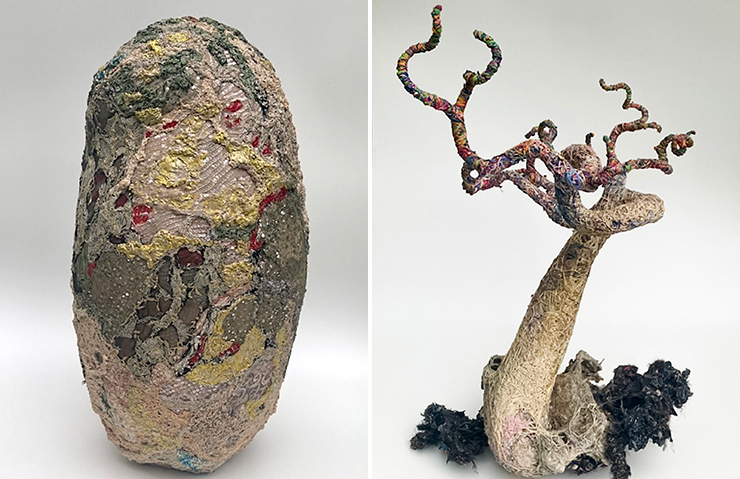
Guerra de la Paz, Bridge Red Studios. (Photo courtesy of Bridge Red).
Guerra de la Paz is “repurposing mass-produced materials,” focusing on the “organic processes of additive methods similar to those found in nature.” Using “woven fiber networks and fabrics sewn tightly together,” they marry techniques from other cultures, i.e. the piece titled “Standing Rock -Formation 1” brings in their fascination with Japanese Zen Rock Gardens with an art called Sazare-ishi, “boulders formed from smaller stones fused together.” The work named “Formation-1” again is taken from Japan with a nod to the technique Boro patchwork. The artists “repurposed pillows, compressed and tightly bound with rope”.
Multiple thoughts and interests consider “the cosmic rules of construction as we manipulate into existence sculptural compositions that evoke synthetic organisms and minerals, merging the geological with the supernatural and integrating artificiality with nature.”
I asked painter Kristen Thiele (who runs Bridge Red Studios/Project Space along with her sculptor/painter father Robert Thiele) a few questions.
Irene Sperber: Why this show, why now?
Kristen Thiele: “I have long wanted to show Guerra de la Paz, the collaborative artists, at BRS/PS. I have once shown them before in 2009 in the Design District in a show called Coupling, in a space provided through a partnership of the Miami Design District and the Art Center South Florida, who in turn asked me to curate the show. It was a great group of artists/couples and a super fun show. I have asked GdlP to show with us here before, so I'm thrilled to be able to show them now.”
IS: What is your gallery mission?
KT: “..To show South Florida connected artists who have established disciplines but do not have representation locally. Our goal is to make a space for the community to have access to these artists and their work. We would also love to be able to facilitate a connection to museums and art institutions who may not have been exposed to these artists.”
I’m noticing many artists and institutions utilize fiber arts this season as I get out to local galleries and museums. Bridge Red, as per its reputation, is showing dramatic usage of these arts. Guerra de la Paz is no shrinking violet, using their chosen media variations to the fullest advantage, activating strong visual clues for impact.
Bridge Red Exhibition Space
12425 NE 13th Ave
North Miami, FL 33161
Opening Reception: Sunday, Nov 19, 4 to 7 p.m.
Closing Brunch: Sunday, Jan 7, 2024, Noon to 3 p.m
Call or text for appt. at 305-978-4856 or www.bridgeredstudios.com
Pattern and Decoration at The Frost Art Museum at FIU
The recently opened “Embellish Me” exhibition on the FIU campus (through Sunday, Jan. 7) is well worth the drive, showing works from the Collection of Norma Canelas Roth and William Roth.
I hot-footed it out to west Miami-Dade after the Kampong viewing for the opening day of a 50-piece show highlighting “world-renowned Pattern & Decoration artists”.
I needed to see how the late 1970s rogue movement of P&D artists conceptualized patterns, engaged nature, challenged observation, and why the exhibition fits a greater whole beyond visual engagement.
The fact that art had previously been male-centric is not a big reveal. The P&D movement addressed the gender issue which skewed discussion before the 1970s about which art mattered, not only from a white male perspective but with a bent toward a “West is best” limited point of view.
Two female artists, both represented here, decided to legitimize what was heretofore considered art that was lesser than. Valerie Jaudon and Joyce Kozloff are on exhibition in “Embellish Me,” a title that honors decoration, elevating the “feminine arts” as worth its own heavyweight status.
Curator and passionate collector Norma Canelas Roth, a long-time resident of Florida from Puerto Rico, passed away last year. She had not yet realized her ambition to show the comprehensive collection, now honored here. Twenty-three artists affiliated with the P&D movement of the ’70s are featured, displaying a handmade aesthetic not emphasized during the more popular art trends of the time: conceptualism, Pop Art, and Minimalism.
Canelas Roth collected art that was often neglected by mainstream art dealers, critics, and curators.
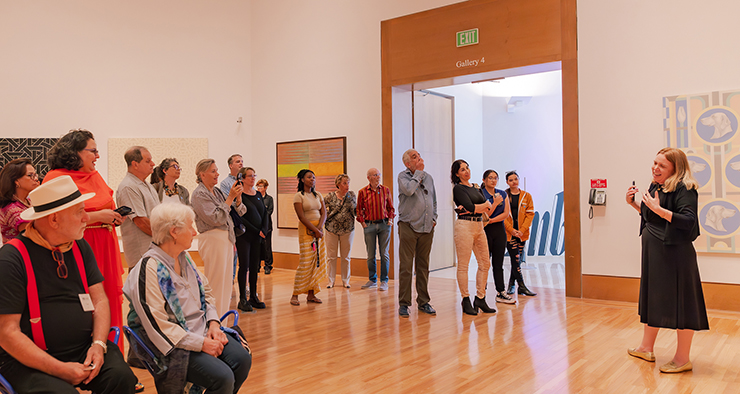
Frost curator Amy Galpin discusses the "Embellish Me" exhibition with opening day visitors. (Photo courtesy of FIU Frost Museum).
On deck for discussion and dissection are fiber arts, embroidery, mosaics, sharing a place with paint on canvas, wood, tiles, etc. During the opening, Frost Museum curator Amy Galpin corralled several of the artists to give talks on thought, process and composition. QR codes are placed around the gallery for further information.
Ned Smyth, based on Shelter Island, N.Y., spoke in front of his fabric design work emphasizing sumptuous green on green fabric palm fronds. Smyth underlined that he does whole environments, rather than objects. This piece is part of a chapter and not the entire story. The arched shape was plucked from his upbringing in Italy, living among exquisite artwork as a child influenced his day-to-day experience, bringing deeper historical meaning to the work.
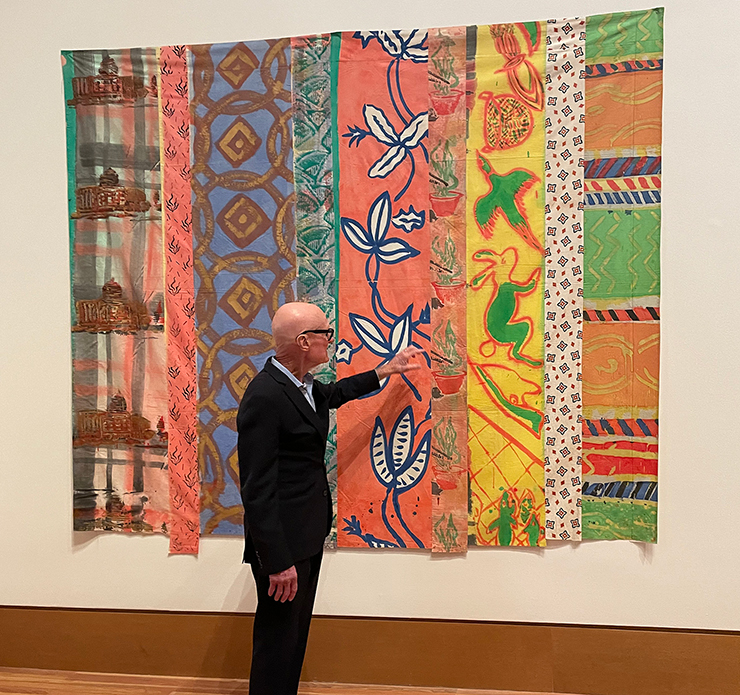
Artist Kim MacConnell discussing his large-scale work at the Frost Museum. (Photo by Irene Sperber).
Artist Kim MacConnell, another essential figure in the movement, stood in front of his piece explaining household references forming patterns on large interconnected strips of cotton sheeting. He took us through process, introducing thoughts to consider. Artists work out personal and societal problems in their pieces; we then process their process, coming to new conclusions of our own. A good conduit to an epiphany or two, making the journey to both the inner and outer world becomes a path to a wider wholeness. Some of the fabric strips MacConnell exhibits are enlarged prints of lace designs, showing his interpretive chops.
MacConnell says: “I see how structure and form move from strip to strip of fabric and stretches out the pattern.” (Now I’m wondering how I can use his M.O. to interpret and connect our disjoint current societal norm.)
Jane Kaufman, a feminist in the Guerilla Girl movement (activated 1985) in NYC focussed on combatting sexism and racism within the art world. Her very literal piece, “Pearl Screen,” indicates a divider between domestic and intimate space.
My day finished steeped in thought. Exhibitions engage and sort out that hamster wheel mind often crammed with unnecessary rubble of daily existence.
I was not well versed on the Pattern and Decoration movement and ready to expand on the idea of patterning, making sense out of nature since the ancient Greeks became aware of “divine proportion,” or the golden ratio (1.618) which is visible natural forms, i.e.the spiral patterns in seashells, the branching of trees, or the shape of a human face.
The golden ratio has been studied by many mathematicians and artists throughout history, including Pythagoras, Leonardo da Vinci, and Fibonacci. The subject of Patterns and Decoration stretches your realm with FIU’s latest mind-altering peek into the fractions of human experience.
Along with “Embellish Me,” the Frost furthers illumination with the exhibition “To Recognize a Pattern”…works of Pattern and Decoration with three contemporary artists: Mark Fleuridor, Ashnide Jean-Baptiste, and Vickie Pierre. These current artists bring a fresh expanded angle to the P&D movement.
Post Script: At the precise moment I was finishing up this piece, FIU sent an email blast that the Art Bridges Foundation announced The Frost as one of the 64 museums to be one of the grant recipients of their initiative to attract visitors to museums throughout the United States.
The grant is to “build relationships with new audiences, engage current audiences in new ways, and emphasize interdisciplinary programming.”
With all three of my review choices now incorporating the word “bridge,” I cannot ignore that underlined message of the necessity to create connection . . as a community, as residents of the world, and as equally responsible for reaching out to span a larger communication and understanding.
As FIU noted in their response: “We are grateful to Art Bridges for their commitment to reducing barriers to access and strengthening community relationships.
Be sure to check the website regularly for information on FIU’s other exhibitions, lectures and programming.
"Embellish Me"
Through Sunday, Jan 7, 2024
Frost Art Museum, FIUModesto Maidique Campus
10975 SW 17 St.
Miami 333199
Info: Frost Art Museum-FIU




